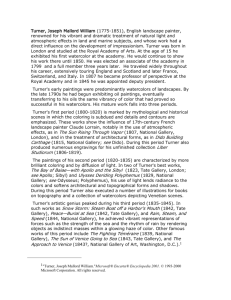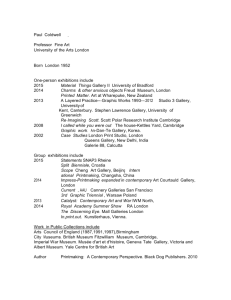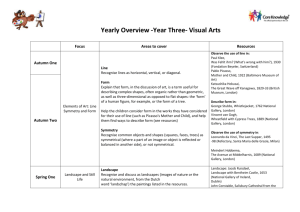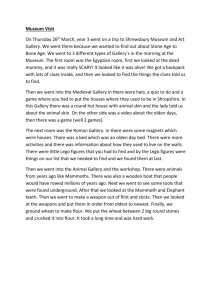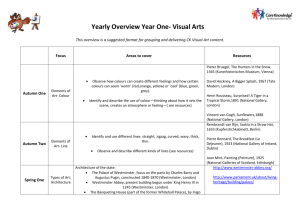The National Gallery
advertisement
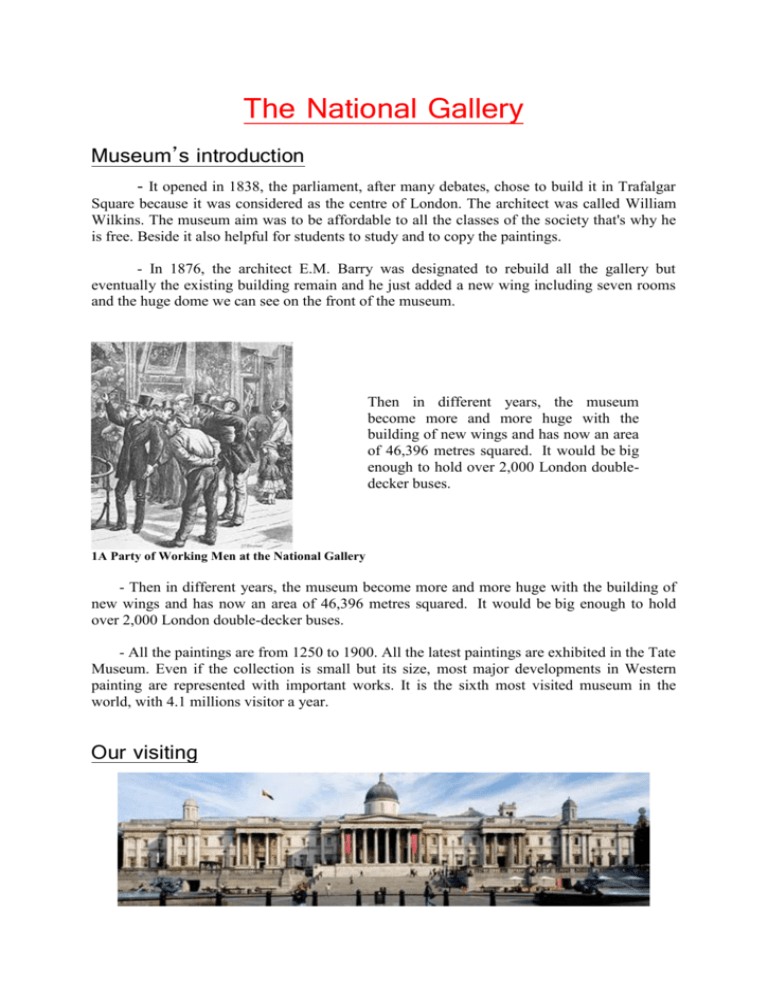
The National Gallery Museum’s introduction - It opened in 1838, the parliament, after many debates, chose to build it in Trafalgar Square because it was considered as the centre of London. The architect was called William Wilkins. The museum aim was to be affordable to all the classes of the society that's why he is free. Beside it also helpful for students to study and to copy the paintings. - In 1876, the architect E.M. Barry was designated to rebuild all the gallery but eventually the existing building remain and he just added a new wing including seven rooms and the huge dome we can see on the front of the museum. Then in different years, the museum become more and more huge with the building of new wings and has now an area of 46,396 metres squared. It would be big enough to hold over 2,000 London doubledecker buses. 1A Party of Working Men at the National Gallery - Then in different years, the museum become more and more huge with the building of new wings and has now an area of 46,396 metres squared. It would be big enough to hold over 2,000 London double-decker buses. - All the paintings are from 1250 to 1900. All the latest paintings are exhibited in the Tate Museum. Even if the collection is small but its size, most major developments in Western painting are represented with important works. It is the sixth most visited museum in the world, with 4.1 millions visitor a year. Our visiting - The National Gallery is situated on the north of Trafalgar square. Just in front of it there is a big place with fountains and big lions. - To enter the National Gallery, you need to take a big and ancient stair which lead you to a more modern hall. Then you just have to take another stair and you can lose yourself in the successions of big rooms. This museum is a real maze ! But such a magnificent maze ! - Just after having pass the great door, you just have to walk and lose yourself in the succession of high rooms, with gold-coulored ceilings, and enormous arches ! These rooms seem to come right from the past ! And it's quite true : this museum was founded in 1838 ! - Even if there are not a lots of world-famous paintings you can find a lot of Turner or Gainsborough's paintings and I thinks it is the best ones ! We have also found a painting we studied (for some of them) last year : "Ambassadors" by Hilbein. - All the paintings are from the Middle-Age to the XIXth century, there also is one room of modern art. Each room is dedicated to someone or something, for example, you can find the French room. - Admire such great paintings is a real pleasure, you can walk through the History, the Time and admire lovely paintings. A painter and a painting Joseph Mallord William Turner (We decided to choose the famous painter Turner who is exposed in the National Gallery) William Turner was born on the 23th April 1775 in London. He was a Romantic painter, watercolourist and printmaker. His father, William Gay Turner, was a barber and wig maker and his mother, Mary Marshall, became mentally unstable, possibly because of Turner's younger sister, Mary Ann Turner, in 1786. So she died in 1804. Turner was send very early with his uncle in 1785 in Brentford. He entered in the Royal Academy of Art, when he was only 15 years old. First, Turner interested in architecture, then one of his watercolour was accepted for the Summer Exhibition of 1790 after only one year of studied. After that, he exhibited each year in the Royal Academy. During his career, he travelled a lot: in England, Scotland and France (where he studied in Le Louvre). He also went in Venice many times. He was influenced a lot by his travels. He influenced the French art and he opened the way to impressionism. He was not conformist and he did not respect the paint code. For him, the light was very important. With the age, he became eccentric, depressive and he did not have many friends. He had two daughters with Sarah Dandy but he never got married with her. He died in the house of his mistress Sophia Caroline Booth in Cheyne Walk, Chelsea on 19 December 1851. Now many of his painting are in the National Gallery and in the Tate in London. Turner, Ulysses Deriding Polyphemus, National Gallery, London (1829) Turner, Modern Rome-Campo Vaccio, National Gallery, London (1839) Rain, Steam and Speed - The Great Western Railway Rain, Steam and Speed is one of Turner painting which is now exhibit in the room 34 in the National Gallery, in London. It was painted in 1844 so at the end of his career. This painting was first exhibited in the Royal Academy. It is a oil on canvas. There are cold (blue, brown...) and warm (yellow, orange...) colours. On the foreground we hardly can see a train on a bridge across the river Thames between Taplow and Maidenhead. On the right we can see the misty landscape. We can not make the difference between the rain, the sky and the river. On the right, in the background, there is an other bridge. The topic is very modern and unusual, it represents the industrial revolution with the train. It subtitles : the Great Western Railway refers to one of a private British railway companies. It shows the power which overcome the nature. Chloé Albesa, Olga Bourdereau, Solène Tascone

